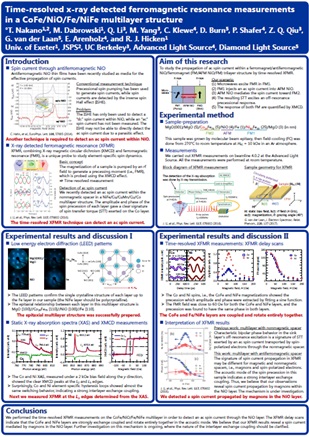
Time-resolved X-ray detected ferromagnetic resonance measurements of a CoFe/NiO/Fe/NiFe multilayer structure
T. Nakano, M. Dabrowski, Q. Li, M. Yang, C. Klewe, D.M. Burn, P. Shafer, Z.Q. Qiu, G. van der Laan, E. Arenholz, and R.J. Hicken
Emerging Applications of Spin Transfer Torque Exeter Jun 2018
Antiferromagnetic NiO films have been studied as media for the effective propagation of spin currents, mostly by means of the inverse spin Hall effect (ISHE) [1]. However their study is still incomplete because ISHE has only been used to probe the dc spin current, while the ac spin current has not been measured. X-ray detected ferromagnetic resonance (XFMR) allows an ac spin current to be detected via the spin transfer torque exerted upon a ferromagnet [2]. To this end, time-resolved element-specific XFMR measurements were performed upon a CoFe/NiO/Fe/NiFe multilayer. Microwaves of 4 GHz frequency were supplied through a coplanar waveguide (CPW) with a variable phase relative to the x-ray pulses, so as to generate an in-plane rf magnetic field orthogonal to the axis of the CPW, while a static magnetic field of magnitude H was applied parallel to the axis. Figure 1(a) shows XFMR delay scans acquired at the Co and Ni edges of the CoFe and NiFe layers respectively. The amplitudes and phases were extracted by fitting sine curves to the data acquired at different values of H, as shown in Figure 1(b) and (c). The FMR field was close to 60 Oe for both the CoFe and NiFe layers, and the precession was found to have very similar phase for both layers. These results indicate that the CoFe and NiFe layers are strongly coupled and exhibit an acoustic precessional mode. Since the intrinsic FMR frequency of the CoFe layer should be much higher than 4 GHz, the XFMR measurements may be interpreted as a signature of spin current propagation mediated by magnons within the NiO layer.

Figure 1. (a) XFMR delay scans measured at different H values, (b) fitted amplitudes, and (c) fitted phases for Co (blue squares) and Ni (red circles) L edges. Sine curves in (a) are fits to the experimental data
References
[1] H. Wang et al., Phys. Rev. Lett. 113, 097202 (2014).
[2] J. Li et al., Phys. Rev. Lett. 117, 076602 (2016).